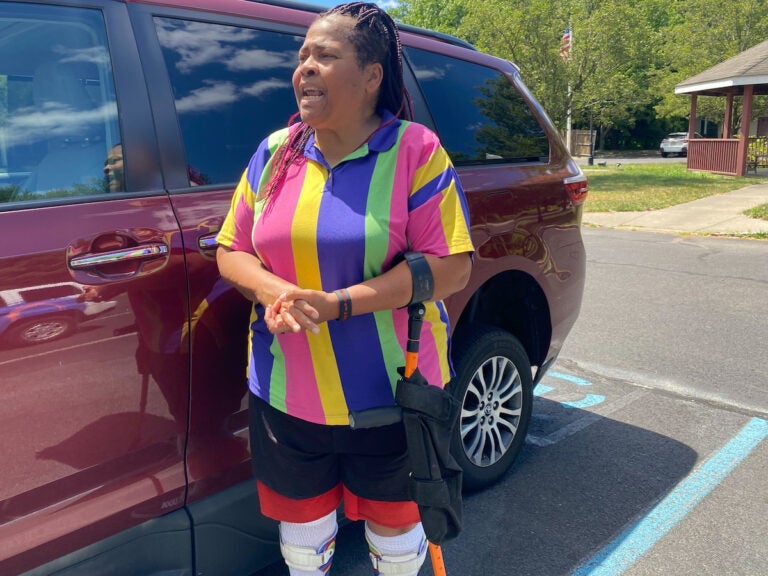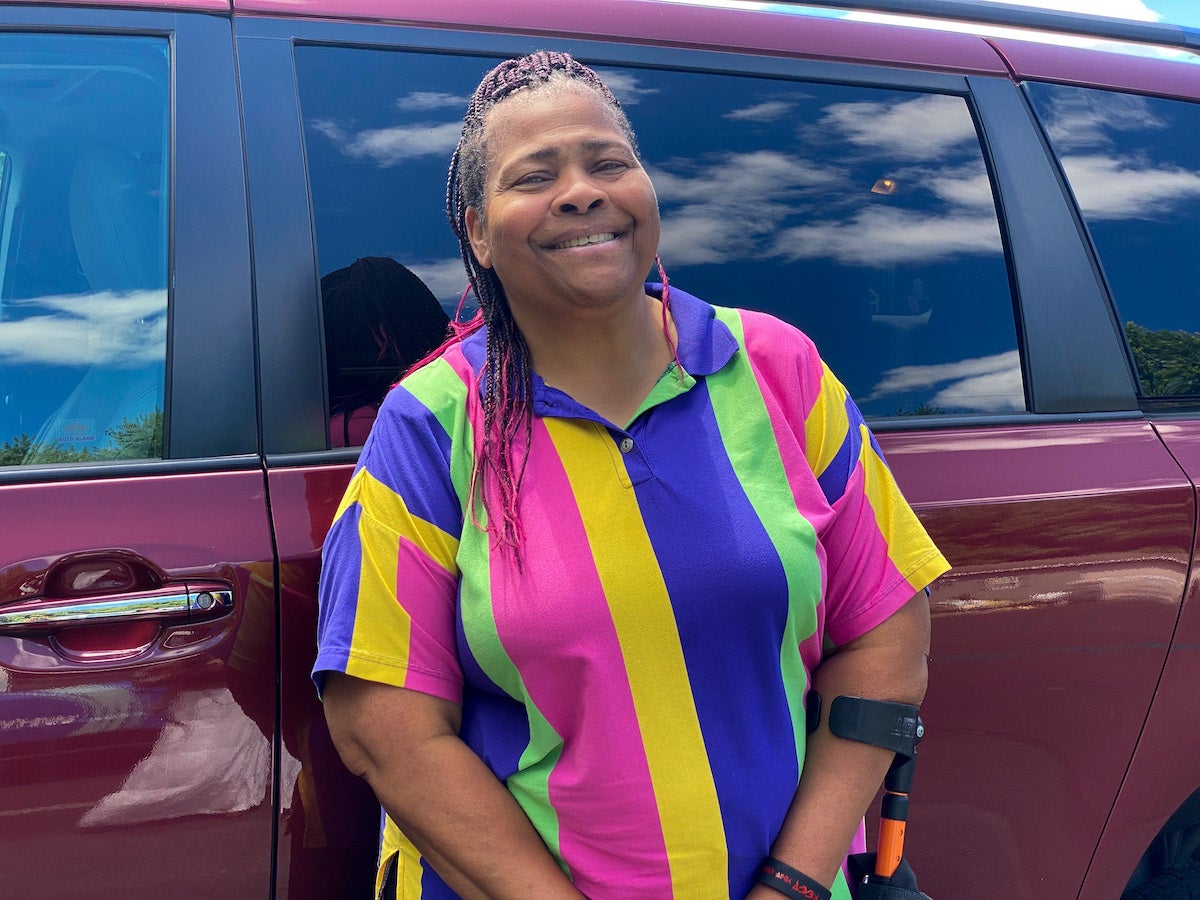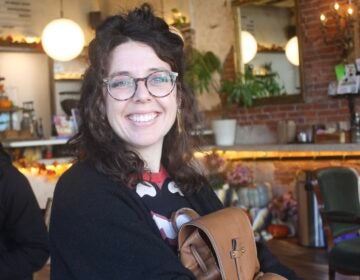Why GoFundMe is not a safety net for some of the most vulnerable users
GoFundMe can feel like a last option for people with large medical bills — but those who utilize public assistance will need to think twice before campaigning.
Listen 13:40
After Patrice Jetter, who has cerebral palsy, used GoFundMe to buy an accessible van, she lost her Section 8 housing and Medicaid. (WHYY/Nichole Currie)
This story is from The Pulse, a weekly health and science podcast.
Find it on Apple Podcasts, Spotify, or wherever you get your podcasts.
Since 1993, Patrice Jetter usually started her day with the same routine — slipping into a chartreuse yellow reflective vest and grabbing a red stop sign before stepping out the door.
Jetter started as a school crossing guard in Montclair, New Jersey. She landed the job after applying 13 times, overcoming doubts that her disability would hinder her ability to perform the assigned duties. Diagnosed with diplegic cerebral palsy as a child, Jetter now uses two leg braces and a crutch as an adult to get around.
“They were really skeptical about hiring me to do the job,” Jetter said. “I turned out to be one of the best crossing guards they had.”
Jetter now works in Hamilton, New Jersey. For years, she has driven a handicapped van to get to work. It includes special modifications and space for her medical equipment. However, as a part-time employee with a disability, she has often depended on donated vans that have been previously used by organizations.
“But a lot of times when you get vans that are donated — they’re very old,” Jetter said. “And they spend a lot of time in the shop.”
In 2015, Jetter’s van required a part that was no longer manufactured, making it inoperable. She couldn’t get to work and was faced with the possibility of resigning from her beloved job. But before making a rash decision, Jetter’s friends encouraged her to explore another option: GoFundMe.
GoFundMe is a popular crowdfunding platform that has empowered individuals to seek financial help. Initially intended for entrepreneurs to fund their ideas, it quickly became a resource for those needing help with medical bills or related expenses. Today, one-third of campaigns fund medical expenses.
Jetter initially hated the idea of asking for help, but ultimately, decided to go forward with the campaign.
It proved successful — very successful. Donations from her community and even strangers helped her raise funds for a used van. Jetter was grateful that she could begin looking for a van and keep her job.
But the relief she felt soon diminished.
She received a letter stating she no longer qualified for the New Jersey housing choice voucher program — a system that helps residents pay for rent. They often give priority to people who are disabled.
“They had removed me off the rental assistance program because I had $6,000 in assets that I didn’t report,” Jetter said.
At first, Jetter had no idea what assets the state was referencing.
“I had to think, what are they talking about?’ And then when I began thinking, ‘I’m like, oh man — it was the GoFundMe.’”
Subscribe to The Pulse
The housing program requires participants to report any form of monetary gain — including gifts and donations — as income under their guidelines.
“It just makes you feel so dejected. Where there’s very few programs out here to help a person like myself and … they treat you like you’re stealing from the government when you’re just trying to help yourself stay afloat.”
Jetter’s GoFundMe campaign also resulted in her losing Medicaid, a health insurance program she relied on.
After that, she rejected further donations. With the consent of her donors, and without the assistance she once had from the housing program, she used the funds from her campaign to cover her rent. Thanks to the assistance of advocates, Jetter managed to re-enter both programs after four months restoring her housing and medical benefits.
But with no accessible van, Jetter was forced to resign from her role as a crossing guard.
A problem before GoFundMe
The challenges Jetter faced due to her GoFundMe campaign are not uncommon.
Stephen Dale, an attorney, and founder of Dale Law Firm in Pacheco, California, says that fundraising has long been a risky endeavor for individuals in public assistance programs, often leading to unforeseen complications.
“If I look in the old days…you’d read in the paper about some tragedy or something,” Dale said. “And then if you’d like to make a donation, make the donation to this account in Wells Fargo or whatever, and there’s a really good chance that’s going to end up on my table.”
Dale says GoFundMe just intensified the issue.
To maintain eligibility for programs such as Supplemental Security Income (SSI), Medicaid, food stamps, and Section 8 housing, individuals must report any income and adhere to strict asset limits. While crowdfunding to pay an outstanding medical bill may seem harmless, it can easily push individuals over their asset thresholds.
If a crowdfunding account is established by someone receiving public assistance, or if the funds are meant for direct distribution to them, the money is often categorized as unearned income. Dale explains that this occurs partly because many public assistance programs have yet to publish clear guidelines addressing crowdfunding.
These strict guidelines are notorious for preventing people from saving money to transition out of assistance programs or from accepting necessary monetary gifts for unexpected expenses.
While Dale often helps his clients transition out of these programs, he notes that there are few little-known options for those needing to fundraise while retaining their benefits.
One such option is an Achieving a Better Life Experience (ABLE) account. This account allows individuals to save up to $18,000 per year without jeopardizing their benefits. It is also advisable for GoFundMe funds to be deposited directly into an ABLE account rather than a personal account, as that could lead to complications later.
But Dale says it’s not a one-size-fits-all solution due to eligibility guidelines. For example: You must be disabled before the age of 26 to qualify.
A second approach, Dale says, is to strategically navigate the system. Since SSI and Medicaid operate on a monthly calendar cycle, recipients can spend their donated funds before the end of the month, risking only one month of limited benefits or overpayment. However, this method can be unreliable. For instance, some individuals may not be able to purchase medical equipment immediately.
When in doubt, look for hope
Navigating public assistance programs can be daunting and the risk of losing benefits — even temporarily — due to crowdfunding for medical expenses is too great a risk for some people.
There are efforts to reform guidelines for SSI, Medicaid, and Section 8, which could allow individuals to retain more savings and provide clearer regulations on crowdfunding. However, Dale says that meaningful change is unlikely to happen soon.
In the meantime, individuals at risk of losing their benefits can turn to two organizations that assist patients in raising funds to cover medical bills. The Children’s Organ Transplant Association in Bloomington, Indiana, is one option, while the nonprofit Help Hope Live in Radnor, Pennsylvania is another.
Help Hope Live specializes in helping those facing medical expenses related to chronic illnesses and specific organ transplants across the country. The organization verifies applicants’ medical needs and provides personalized fundraising guidance.
Most importantly, the raised funds are never deposited into the fundraiser’s account, instead, Help Hope Live pays the bills for them. This method ensures that the bills are settled without jeopardizing the beneficiary’s eligibility for SSI, Medicaid or Section 8 housing.
“Many families come to us, and they have an active GoFundMe and they say things like, ‘Can we transfer our GoFundMe money because we just found out that we’re going to lose Medicaid?’” Kelly Green, executive director, said.
Help Hope Live has been in operation for over 40 years, assisting more than 20,000 families. Green has often wondered why similar organizations haven’t emerged. She attributes it to the challenges of maintaining their charitable status.
“We are audited, and our audits are extreme,” Green said.
Because the nonprofit directly pays the bills for individuals, it must manage numerous accounts and transactions. She says reviewing their financial records can take months.
Still, their organization can reach people in need, such as Patrice Jetter.

Jetter turned to Help Hope Live a few years after her experience with GoFundMe. The nonprofit was able to help her raise $60,000 to purchase a 2019 accessible van.
Jetter’s van is in the color of pearl red, and it is decorated in her favorite color, hot pink. She has been able to return to her crossing guard post in Hamilton, New Jersey.
WHYY is your source for fact-based, in-depth journalism and information. As a nonprofit organization, we rely on financial support from readers like you. Please give today.







